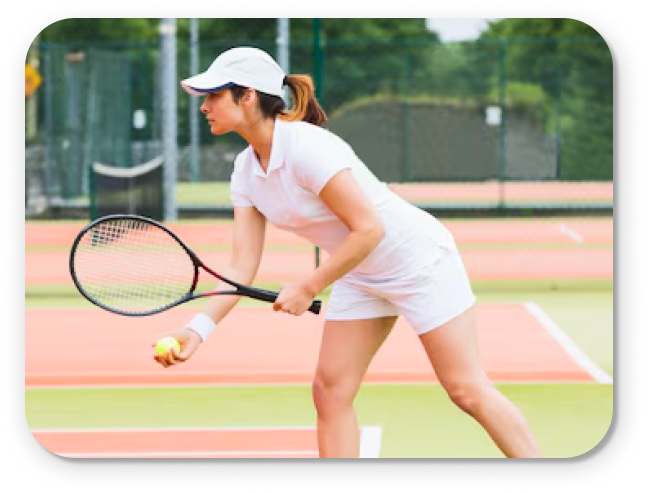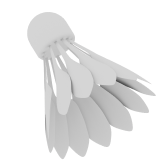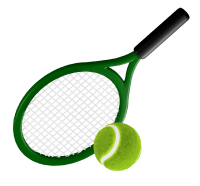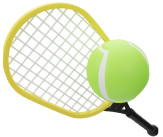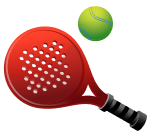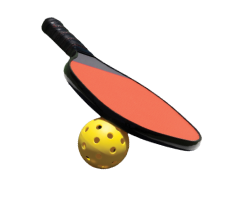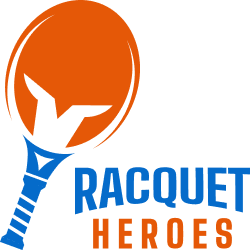Tennis
Know all the basic Tennis rules and regulations, how to play the game,
court lines, how to score points and more!
1. the court
The court shall be a rectangle, 78 feet (23.77 m) long and, for singles matches, 27 feet (8.23 m) wide. For doubles matches, the court shall be 36 feet (10.97 m) wide.
The court shall be divided across the middle by a net suspended by a cord or metal cable which shall pass over or be attached to two net posts at a height of 3 ½ feet (1.07 m). The net shall be fully extended so that it completely fills the space between the two net posts, and it must be of sufficiently small mesh to ensure that a ball cannot pass through it. The height of the net shall be 3 feet (0.914 m) at the centre, where it shall be held down tightly by a strap. A band shall cover the cord or metal cable and the top of the net. The strap and band shall be completely white.
- The maximum diameter of the cord or metal cable shall be 1/3 inch (0.8 cm).
- The maximum width of the strap shall be 2 inches (5 cm).
- The band shall be between 2 inches (5 cm) and 2½ inches (6.35 cm) deep on each side.
For doubles matches, the centres of the net posts shall be 3 feet (0.914 m) outside the doubles court on each side.
For singles matches, if a singles net is used, the centres of the net posts shall be 3 feet (0.914 m) outside the singles court on each side. If a doubles net is used, then the net shall be supported, at a height of 3½ feet (1.07 m), by two singles sticks, the centres of which shall be 3 feet (0.914 m) outside the singles court on each side.
- The net posts shall not be more than 6 inches (15 cm) square or 6 inches (15 cm) in diameter
- The singles sticks shall not be more than 3 inches (7.5 cm) square or 3 inches (7.5 cm) in diameter.
- The net posts and singles sticks shall not be more than 1 inch (2.5 cm) above the top of the net cord.
The lines at the ends of the court are called baselines and the lines at the sides of the court are called sidelines.
Two lines shall be drawn between the singles sidelines, 21 feet (6.40 m) from each side of the net, parallel with the net. These lines are called the servicelines. On each side of the net, the area between the serviceline and the net shall be divided into two equal parts, the service courts, by the centre serviceline. The centre serviceline shall be drawn parallel with the singles sidelines and half-way between them.
Each baseline shall be divided in half by a centre mark, 4 inches (10 cm) in length, which shall be drawn inside the court and parallel with the singles sidelines.
- The centre serviceline and centre mark shall be 2 inches (5 cm) wide.
- The other lines of the court shall be between 1 inch (2.5 cm) and 2 inches (5 cm) wide, except that the baselines may be up to 4 inches (10 cm) wide.
All court measurements shall be made to the outside of the lines and all lines of the court shall be of the same colour clearly contrasting with the colour of the surface.
No advertising is allowed on the court, net, strap, band, net posts or singles sticks except as provided in Appendix IV.

In addition to the court described above, the court designated as “Red” and the court designated
as “Orange” in Appendix VII can be used for 10 and under tennis competition.
2. permanent fixtures
The permanent fixtures of the court include the backstops and sidestops, the spectators, the stands and seats for spectators, all other fixtures around and above the court, the chair umpire, line umpires, net umpire and ball persons when in their recognised positions.
In a singles match played with a doubles net and singles sticks, the net posts and the part of the net outside the singles sticks are permanent fixtures and are not considered as net posts or part of the net.
3. the ball
Balls, which are approved for play under the Rules of Tennis, must comply with the
specifications in Appendix I .
The International Tennis Federation shall rule on the question of whether any ball or prototype complies with Appendix I or is otherwise approved, or not approved, for play. Such ruling may be taken on its own initiative or upon application by any party with a bona fide interest therein, including any player, equipment manufacturer or National Association or members thereof. Such rulings and applications shall be made in accordance with the applicable Review and Hearing Procedures of the International Tennis Federation (see Appendix XI).
3.1 The event organisers must announce in advance of the event:
- The number of balls for play (2, 3, 4 or 6).
- The ball change policy, if any.
3.2 Ball changes, if any, can be made either:
-
After an agreed odd number of games, in which case, the first ball change in the match shall take place two games earlier than for the rest of the match, to make allowance for the warm-up. A tie-break game counts as one game for the ball change. A ball change shall not take place at the beginning of a tie-break game: in this case, the ball change shall be delayed until the beginning of the second game of the next set; or
-
At the beginning of a set.
-
If a ball gets broken during play, the point shall be replayed.
Case 1: If a ball is soft at the end of a point, should the point be replayed?
Decision: If the ball is soft, not broken, the point shall not be replayed.
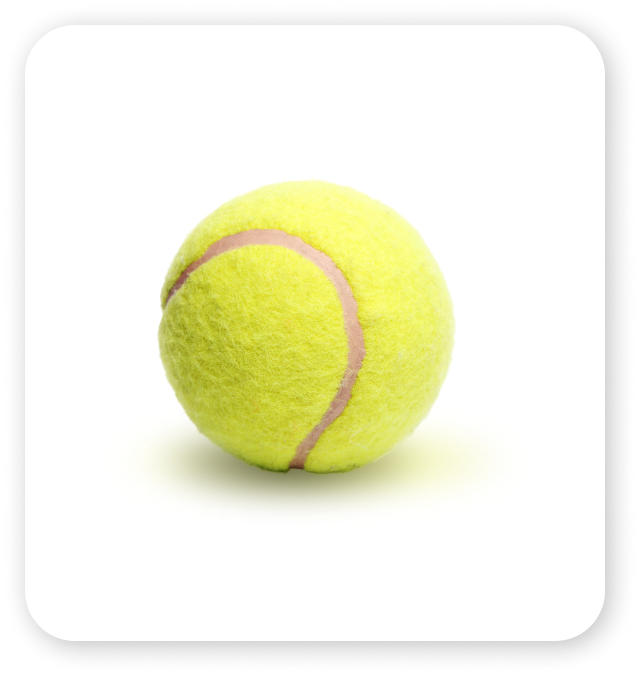
Note:
Any ball to be used in a tournament which is played under the Rules of Tennis must be named on the official ITF list of approved balls issued by the International Tennis Federation.
4. the racquet
Racquets, which are approved for play under the Rules of Tennis, must comply
with the specifications in Appendix II.
The International Tennis Federation shall rule on the question of whether any Racquett or prototype complies with Appendix II or is otherwise approved, or not approved, for play. Such ruling may be undertaken on its own initiative or upon application by any party with a bona fide interest therein, including any player, equipment manufacturer or National Association or members thereof. Such rulings and applications shall be made in accordance with the applicable Review and Hearing Procedures of the International Tennis Federation (see Appendix XI).
Case 1: Is more than one set of strings allowed on the hitting surface of a Racquet?
Decision: No. The rule mentions a pattern (not patterns) of crossed strings. (See Appendix II)
Case 2: Is the stringing pattern of a Racquet considered to be generally uniform and flat if the strings are on more than one plane?
Decision: No.
Case 3: Can vibration damping devices be placed on the strings of a Racquet? If so, where can they be placed?
Decision: Yes, but these devices may only be placed outside the pattern of the crossed strings.
Case 4: During a point, a player accidentally breaks the strings. Can the player continue to play another point with this Racquet?
Decision: Yes, except where specifically prohibited by event organisers.
Case 5: Is a player allowed to use more than one Racquet at any time during play?
Decision: No
Case 6: Can a battery that affects playing characteristics be incorporated into a Racquet?
Decision: No. A battery is prohibited because it is an energy source, as are solar cells and other similar devices.

5. score in a game
5.1 Standard Game
A standard game is scored as follows with the server’s score being called first:
- No point – “Love”
- First point – “15”
- Second point – “30”
- Third point – “40”
- Fourth point – “Game”
except that if each player/team has won three points, the score is “Deuce”. After “Deuce”, the score is “Advantage” for the player/team who wins the next point. If that same player/team also wins the next point, that player/team wins the “Game”; if the opposing player/team wins the next point, the score is again “Deuce”. A player/team needs to win two consecutive points immediately after “Deuce” to win the “Game”.
5.2 Tie-break game
During a tie-break game, points are scored “Zero”, “1”, “2”, “3”, etc. The first player/team to win seven points wins the “Game” and “Set”, provided there is a margin of two points over the opponent(s). If necessary, the tie-break game shall continue until this margin is achieved.
The player whose turn it is to serve shall serve the first point of the tie-break game. The following two points shall be served by the opponent(s) (in doubles, the player of the opposing team due to serve next). After this, each player/team shall serve alternately for two consecutive points until the end of the tie-break game (in doubles, the rotation of service within each team shall continue in the same order as during that set).
The player/team whose turn it was to serve first in the tie-break game shall be the receiver in the first game of the following set.
Additional approved alternative scoring methods can be found in Appendix V.

6. score in a set
There are different methods of scoring in a set. The two main methods are the “Advantage Set” and the “Tie-break Set”. Either method may be used provided that the one to be used is announced in advance of the event. If the “Tie-break Set” method is to be used, it must also be announced whether the final set will be played as a “Tie-break Set” or an “Advantage Set”.
- “Advantage Set” The first player/team to win six games wins that “Set”, provided there is a margin of two games over the opponent(s). If necessary, the set shall continue until this margin is achieved.
- “Tie-break Set” The first player/team to win six games wins that “Set”, provided there is a margin of two games over the opponent(s). If the score reaches six games all, a tie-break game shall be played.
Additional approved alternative scoring methods can be found in Appendix V.
7. score in a match
A match can be played to the best of 3 sets (a player/team needs to win 2 sets to win the match) or to the best of 5 sets (a player/team needs to win 3 sets to win the match).
Additional approved alternative scoring methods can be found in Appendix V.
8. server and receiver
The players/teams shall stand on opposite sides of the net. The server is the player who puts the ball into play for the first point. The receiver is the player who is ready to return the ball served by the server.
Case 1: Is the receiver allowed to stand outside the lines of the court?
Decision: Yes. The receiver may take any position inside or outside the lines on the receiver’s side of the net.
9. choice of ends and service
The choice of ends and the choice to be server or receiver in the first game shall be decided by toss before the warm-up starts. The player/team who wins the toss may choose:
- To be server or receiver in the first game of the match, in which case the opponent(s) shall choose the end of the court for the first game of the match; or
- The end of the court for the first game of the match, in which case the opponent(s) shall choose to be server or receiver for the first game of the match; or
- To require the opponent(s) to make one of the above choices.
Case 1: Is the receiver allowed to stand outside the lines of the court?
Decision: Yes. The receiver may take any position inside or outside the lines on the receiver’s side of the net.
10. change of ends
The choice of ends and the choice to be server or receiver in the first game shall be decided by toss before the warm-up starts. The player/team who wins the toss may choose:
- During a tie-break game, players shall change ends after every six points.
- Additional approved alternative procedures can be found in Appendix V.
11. ball in play
Unless a fault or a let is called, the ball is in play from the moment the server hits the ball,
and remains in play until the point is decided.

12. ball touches a line
If a ball touches a line, it is regarded as touching the court bounded by that line
13. ball touches a permanent fixture
If the ball in play touches a permanent fixture after it has hit the correct court, the player who hit the ball wins the point. If the ball in play touches a permanent fixture before it hits the ground, the player who hit the ball loses the point.
14. order of service
At the end of each standard game, the receiver shall become the server and the server shall become the receiver for the next game.
In doubles, the team due to serve in the first game of each set shall decide which player shall serve for that game. Similarly, before the second game starts, their opponents shall decide which player shall serve for that game. The partner of the player who served in the first game shall serve in the third game and the partner of the player who served in the second game shall serve in the fourth game. This rotation shall continue until the end of the set.
15. order of receiving in doubles
The team which is due to receive in the first game of a set shall decide which player shall receive the first point in the game. Similarly, before the second game starts, their opponents shall decide which player shall receive the first point of that game. The player who was the receiver’s partner for the first point of the game shall receive the second point and this rotation shall continue until the end of the game and the set. After the receiver has returned the ball, either player in a team can hit the ball.
Case 1: Is one member of a doubles team allowed to play alone against the opponents?
Decision: No
16. the service
Immediately before starting the service motion, the server shall stand at rest with both feet behind (i.e. further from the net than) the baseline and within the imaginary extensions of the centre mark and the sideline.
The server shall then release the ball by hand in any direction and hit the ball with the Racquet before the ball hits the ground. The service motion is completed at the moment that the player’s Racquet hits or misses the ball. A player who is able to use only one arm may use the Racquet for the release of the ball.
17. serving
When serving in a standard game, the server shall stand behind alternate halves of the court, starting from the right half of the court in every game.
In a tie-break game, the service shall be served from behind alternate halves of the court, with the first served from the right half of the court.
The service shall pass over the net and hit the service court diagonally opposite before the receiver returns it
18. foot fault
18.1 During the service motion, the server shall not:
- Change position by walking or running, although slight movements of the feet are permitted; or
- Touch the baseline or the court with either foot; or
- Touch the area outside the imaginary extension of the sideline with either foot; or
- Touch the imaginary extension of the center mark with either foot
18.2 If the server breaks this rule it is a “Foot Fault”.
Case 1: Is the server allowed to have one or both feet off the ground?
Decision: Yes

19. service fault
19.1 The service is a fault if:
- The server breaks Rules 16, 17 or 18; or
- The server misses the ball when trying to hit it; or 9
- The ball served touches a permanent fixture, singles stick or net post before it hits the ground; or
- The ball served touches the server or server’s partner, or anything the server or server’s partner is wearing or carrying
Case 1: After tossing a ball to serve, the server decides not to hit it and catches it instead. Is this a fault?
Decision: No. A player, who tosses the ball and then decides not to hit it, is allowed to catch the ball with the hand or the Racquet, or to let the ball bounce.
Case 2: During a singles match played on a court with net posts and singles sticks, the ball served hits a singles stick and then hits the correct service court. Is this a fault?
Decision: Yes
20. second service
If the first service is a fault, the server shall serve again without delay from behind the same half of the court from which that fault was served, unless the service was from the wrong half
21. when to serve and receive
The server shall not serve until the receiver is ready. However, the receiver shall play to the reasonable pace of the server and shall be ready to receive within a reasonable time of the server being ready.
22. the let during a service
22.1 The service is a let if
- The ball served touches the net, strap or band, and is otherwise good; or, after touching the net, strap or band, touches the receiver or the receiver’s partner or anything they wear or carry before hitting the ground; or
- The ball is served when the receiver is not ready
In the case of a service let, that particular service shall not count, and the server shall serve again, but a service let does not cancel a previous fault.
Additional approved alternative procedures can be found in Appendix V

23. the let
In all cases when a let is called, except when a service let is called on a second service, the whole point shall be replayed.
Case 1: When the ball is in play, another ball rolls onto court. A let is called. The server had previously served a fault. Is the server now entitled to a first service or second service?
Decision: First service. The whole point must be replayed.
24. player loses point
24.1 The point is lost if
- The player serves two consecutive faults; or
- The player does not return the ball in play before it bounces twice consecutively; or
- The player returns the ball in play so that it hits the ground, or before it bounces, an object, outside the correct court; or
- The player returns the ball in play so that, before it bounces, it hits a permanent fixture; or
- The receiver returns the service before it bounces; or
- The player deliberately carries or catches the ball in play on the Racquet or deliberately touches it with the Racquet more than once; or
- The player or the Racquet, whether in the player’s hand or not, or anything which the player is wearing or carrying touches the net, net posts/singles sticks, cord or metal cable, strap or band, or the opponent’s court at any time while the ball is in play; or
- The player hits the ball before it has passed the net; or
- The ball in play touches the player or anything that the player is wearing or carrying, except the Racquet; or
- The ball in play touches the Racquet when the player is not holding it; or
- The player deliberately and materially changes the shape of the Racquet when the ball is in play; or
- In doubles, both players touch the ball when returning it.

25. a good return
25.1 It is a good return if
- The ball touches the net, net posts/singles sticks, cord or metal cable, strap or band, provided that it passes over any of them and hits the ground within the correct court; except as provided in Rule 2 and 24 (d); or
- After the ball in play has hit the ground within the correct court and has spun or been blown back over the net, the player reaches over the net and plays the ball into the correct court, provided that the player does not break Rule 24; or
- The ball is returned outside the net posts, either above or below the level of the top of the net, even though it touches the net posts, provided that it hits the ground in the correct court; except as provided in Rules 2 and 24 (d); or
- The ball passes under the net cord between the singles stick and the adjacent net post without touching either net, net cord or net post and hits the ground in the correct court, or
- The player’s Racquet passes over the net after hitting the ball on the player’s own side of the net and the ball hits the ground in the correct court; or
- The player hits the ball in play, which hits another ball lying in the correct court.
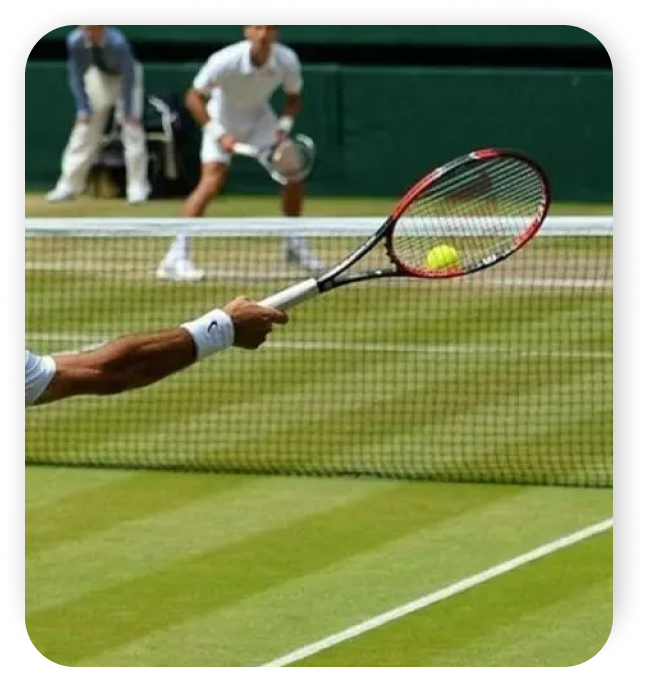
Case 1: A player returns a ball which then hits a singles stick and hits the ground in the correct court. Is this a good return?
Decision: Yes. However, if the ball is served and hits the singles stick, it is a service fault.
Case 2: A ball in play hits another ball which is lying in the correct court. What is the correct decision?
Decision: Play continues. However, if it is not clear that the actual ball in play has been returned, a let should be called.
26. hindrance
If a player is hindered in playing the point by a deliberate act of the opponent(s), the player shall win the point.
However, the point shall be replayed if a player is hindered in playing the point by either an unintentional act of the opponent(s), or something outside the player’s own control (not including a permanent fixture).
Case 1: Is an unintentional double hit a hindrance?
Decision: No. See also Rule 24 (f).
Case 2: A player claims to have stopped play because the player thought that the opponent(s) was being hindered. Is this a hindrance?
Decision: No, the player loses the point.
Case 3: A ball in play hits a bird flying over the court. Is this a hindrance?
Decision: Yes, the point shall be replayed.
Case 4: During a point, a ball or other object that was lying on the player’s side of the net when the point started hinders the player. Is this a hindrance?
Decision: No
Case 5: In doubles, where are the server’s partner and receiver’s partner allowed to stand?
Decision: The server’s partner and the receiver’s partner may take any position on their own side of the net, inside or outside the court. However, if a player is creating a hindrance to the opponent(s), the hindrance rule should be used.
27. correcting errors

27.1 As a principle, when an error in respect of the Rules of Tennis is discovered, all points previously played shall stand. Errors so discovered shall be corrected as follows:
- During a standard game or a tie-break game, if a player serves from the wrong half of the court, this should be corrected as soon as the error is discovered, and the server shall serve from the correct half of the court according to the score. A fault that was served before the error was discovered shall stand.
- During a standard game or a tie-break game, if the players are at the wrong ends of the court, the error should be corrected as soon as it is discovered, and the server shall serve from the correct end of the court according to the score.
- If a player serves out of turn during a standard game, the player who was originally due to serve shall serve as soon as the error is discovered. However, if a game is completed before the error is discovered the order of service shall 13 remain as altered. In this case, any ball change to be made after an agreed number of games should be made one game later than originally scheduled. A fault that was served by the opponents(s) before the error was discovered shall not stand. In doubles, if the partners of one team serve out of turn, a fault that was served before the error was discovered shall stand.
- If a player serves out of turn during a tie-break game and the error is discovered after an even number of points have been played, the error is corrected immediately. If the error is discovered after an odd number of points have been played, the order of service shall remain as altered. A fault that was served by the opponent(s) before the error was discovered shall not stand. In doubles, if the partners of one team serve out of turn, a fault that was served before the error was discovered shall stand
- During a standard game or a tie-break game in doubles, if there is an error in the order of receiving, this shall remain as altered until the end of the game in which the error is discovered. For the next game in which they are the receivers in that set, the partners shall then resume the original order of receiving.
- If in error a tie-break game is started at 6 games all, when it was previously agreed that the set would be an “Advantage set”, the error shall be corrected immediately if only one point has been played. If the error is discovered after the second point is in play, the set will continue as a “Tie-break set”.
- If in error a standard game is started at 6 games all, when it was previously agreed that the set would be a “Tie-break set”, the error shall be corrected immediately if only one point has been played. If the error is discovered after the second point is in play, the set will continue as an “Advantage set” until the score reaches 8 games all (or a higher even number), when a tie-break game shall be played.
- If in error an “Advantage set” or “Tie-break set” is started, when it was previously agreed that the final set would be a match tie-break, the error shall be corrected immediately if only one point has been played. If the error is discovered after the second point is in play, the set will continue either until a player or team wins three games (and therefore the set) or until the score reaches 2 games all, when a match tie-break shall be played. However, if the error is discovered after the second point of the fifth game has started, the set will continue as a “Tie-break set”. (See Appendix V)
- If the balls are not changed in the correct sequence, the error shall be corrected when the player/team who should have served with new balls is next due to serve a new game. Thereafter the balls shall be changed so that the number of games between ball changes shall be that originally agreed. Balls should not be changed during a game.
28. role of court officials
For matches where officials are appointed, their roles and responsibilities can be found in Appendix VI.
29. continuous play
29.1 As a principle, play should be continuous, from the time
the match starts (when the first service of the match is put in play)
until the match finishes.
- Between points, a maximum of twenty-five (25) seconds is allowed. When the players change ends at the end of a game, a maximum of ninety (90) seconds are allowed. However, after the first game of each set and during a tie-break game, play shall be continuous and the players shall change ends without a rest. At the end of each set there shall be a set break of a maximum of one hundred and twenty (120) seconds. The maximum time starts from the moment that one point finishes until the first service is struck for the next point. Event organisers may apply for ITF approval to extend the ninety (90) seconds allowed when the players change ends at the end of a game and the one hundred and twenty (120) seconds allowed at a set break
- If, for reasons outside the player’s control, clothing, footwear or necessary equipment (excluding the Racquet) is broken or needs to be replaced, the player may be allowed reasonable extra time to rectify the problem.

- During a standard game or a tie-break game, if a player serves from the wrong half of the court, this should be corrected as soon as the error is discovered, and the server shall serve from the correct half of the court according to the score. A fault that was served before the error was discovered shall stand.
- During a standard game or a tie-break game, if the players are at the wrong ends of the court, the error should be corrected as soon as it is discovered, and the server shall serve from the correct end of the court according to the score.
- The warm-up time shall be a maximum of five (5) minutes, unless otherwise decided by the event organisers.
All rules reference from The International Tennis Federation – ITF




